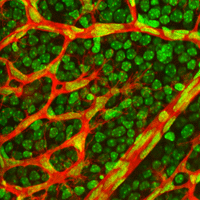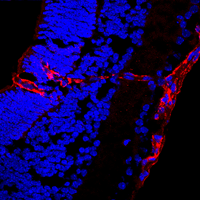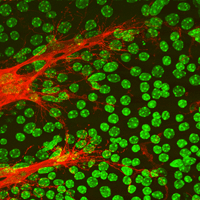Retinal Vascular Development
| Home |
| Research |
| Personnel |
| Publications |
| Funding Acknowledgments |
|
We have shown that formation
of the superficial and deep vascular networks in the neonatal mouse
retina occurs through a mechanism of angiogenesis that utilizes
a pre-existing astrocytic template, endothelial cell filopodial
extensions, and R-cadherin cell adhesion molecules as guidance cues
(Dorrell et. al., 2002). These studies suggest that angiogenesis
and vascular pattern formation in the retina may use many of the
same developmental cues utilized by neurons in both the central
and peripheral nervous systems. Furthermore, unique filopodial extensions
are observed on migrating endothelial cells, facilitating directional
migration during formation of the retinal vasculature. We are currently
characterizing the signaling molecules involved in filopodial-mediated
endothelial cell migration in vivo as well as biochemically characterizing
the nature of the interaction between endothelial cells and astrocytes.
Relevant Publications: Dorrell MI, Aguilar E, Jacobson R, Yanes O, Gariano R, Heckenlively J, Banin E, Ramirez GA, Gasmi M, Bird A, Siuzdak G, Friedlander M. (2009). Antioxidant or neurotrophic factor treatment preserves function in a mouse model of neovascularization-associated oxidative stress. J. Clin. Invest. 119(3): 611-623. PMCID: PMC2648679. Dorrell, M., Usitalo-Jarvinen, H., Aguilar, E.A. and Friedlander, M. (2007). Ocular angiogenesis; basic mechanisms and therapeutic advances. Survey of Ophthalmology, 52:S3-19. Usitalo-Jarvinen, H , T. Kurokawa, B.M. Mueller, P. Andrade-Gordon, M. Friedlander and W. Ruf. (2007). Role of Protease Activated Receptor 1 and 2 Signaling in Hypoxia-Induced Angiogenesis. Arteriosclerosis, Thrombosis, and Vascular Biology, 27:1456-1462. Dorrell, M.I. and Friedlander, M. (2006). Cell guidance in retinal angiogenesis. Progress in Retinal and Eye Research. 25(3):277-95. Ritter, M.R., Aguilar, E., Banin, E., Scheppke, L., Uusitalo-Jarvinen, H., Friedlander, M. (2005). Three-Dimensional In Vivo Imaging of the Mouse Intraocular Vasculature during Development and Disease. Invest. Ophthalmol. Vis. Sci., 46:3021-6. Belting, M., Dorrell, M., Sandgren, S., Ahmad, J., Dorfleutner, D., Carmeliet, P., Mueller, B., Friedlander, M. and Ruf, W. (2004). Tissue factor signalling in angiogenesis. Nature Medicine, 10:502-9. Dorrell, M.I., Aguilar, E. and Friedlander, M. (2004). Global gene expression analysis of the developing post-natal retina. Investigative Ophthal. Vis. Sci., 45:1009-29. Heckenlively, J.R., Hawes, N.L., Friedlander, M., Nusinowitz, S., Ronald Hurd, R., Davisson, M. and Chang, B. (2003).Mouse model of subretinal neovascularization with choroidal anastomosis. Retina, 23(4):518-522. Dorrell, M., Aguilar de Diaz, E., and Friedlander, M. (2002).Developmental vascularization of the retina is mediated by a pre-existing astrocytic template and specific R-cadherin adhesion. Investigative Ophthalmology and Visual Science, 43:3500-3510. |
|
| © 2009 The Scripps Research Institute - All Rights Reserved |



